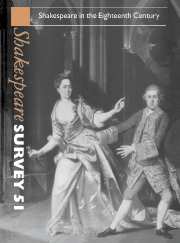Book contents
- Frontmatter
- Shakespeare and the Eighteenth Century: Criticism and Research
- Daddy’s Girls: Shakespearian Daughters and Eighteenth-Century Ideology
- Shakespeare and Clarissa: ‘General Nature’, Genre and Sexuality
- Early Georgian Politics and Shakespeare: The Black Act and Charles Johnson’s Love in a Forest (1723)
- Race Mattered: Othello in Late Eighteenth-Century England
- From Pericles to Marina: ‘While Women are to be had for Money, Love, or Importunity’
- ‘A Thousand Twangling Instruments’: Music and The Tempest on The Eighteenth-Centruy London Stage
- Double Falsehood and the Verbal Parallels with Shelton’s Don Quixote
- Eighteenth-Century Performances of Shakespeare Recorded in the Theatrical Portraits of the Garrick Club
- Eighteenth-Century Editing, ‘Appropriation’, and Interpretation
- Shakespeare Survey: Beginnings and Continuities
- Destined Livery? Character and Person in Shakespeare
- Prejudice and Law in The Merchant of Venice
- ‘Many A Civil Monster’: Shakespeare’s Idea of the Centaur
- Shakespeare’s International Currency
- Repeopling the Globe: The Opening Season at Shakespeare’s Globe, London 1997
- Shakespeare Performances in England, 1997
- Professional Shakespeare Productions in the British Isles, January–December 1996
- TheYear's Contributions to Shakespeare Studies: 1 Critical Studies
- 2 Shakespeare’s Life, Times, and Stage
- 3 Editions and Textual Studies
- Books Received
- Index to Volume 51
- General Index to Volumes 41–50
Double Falsehood and the Verbal Parallels with Shelton’s Don Quixote
Published online by Cambridge University Press: 28 March 2007
- Frontmatter
- Shakespeare and the Eighteenth Century: Criticism and Research
- Daddy’s Girls: Shakespearian Daughters and Eighteenth-Century Ideology
- Shakespeare and Clarissa: ‘General Nature’, Genre and Sexuality
- Early Georgian Politics and Shakespeare: The Black Act and Charles Johnson’s Love in a Forest (1723)
- Race Mattered: Othello in Late Eighteenth-Century England
- From Pericles to Marina: ‘While Women are to be had for Money, Love, or Importunity’
- ‘A Thousand Twangling Instruments’: Music and The Tempest on The Eighteenth-Centruy London Stage
- Double Falsehood and the Verbal Parallels with Shelton’s Don Quixote
- Eighteenth-Century Performances of Shakespeare Recorded in the Theatrical Portraits of the Garrick Club
- Eighteenth-Century Editing, ‘Appropriation’, and Interpretation
- Shakespeare Survey: Beginnings and Continuities
- Destined Livery? Character and Person in Shakespeare
- Prejudice and Law in The Merchant of Venice
- ‘Many A Civil Monster’: Shakespeare’s Idea of the Centaur
- Shakespeare’s International Currency
- Repeopling the Globe: The Opening Season at Shakespeare’s Globe, London 1997
- Shakespeare Performances in England, 1997
- Professional Shakespeare Productions in the British Isles, January–December 1996
- TheYear's Contributions to Shakespeare Studies: 1 Critical Studies
- 2 Shakespeare’s Life, Times, and Stage
- 3 Editions and Textual Studies
- Books Received
- Index to Volume 51
- General Index to Volumes 41–50
Summary
The first English translation of Don Quixote (Part I), by Thomas Shelton, was entered in the Stationers’ Register on 19 January 1610/11, and published in 1612. In the winter of 1612/13 a play called Cardenno or Cardenna was presented by the King’s Men at court, and again on 8 June 1613. Then in 1653 Humphrey Moseley entered a manuscript in the Stationers’ Register as ‘The History of Cardenio, by Mr Fletcher & Shakespeare’. So far as is known, no manuscript of the play has survived. On the face of it, the play was a work of collaboration between the two playwrights, in the line of The Two Noble Kinsmen. Moreover, Cardenio is the name of a character in the first part of Don Quixote, and represents a well-known episode which could have been the source of the lost play.
Then in 1727 a play called Double Falsehood was produced at Drury Lane by Lewis Theobald as an adaptation from Shakespeare, and published the following year. The title-page stated: 'Written originally by W. Shakespeare; And now Revised and Adapted to the Stage By Mr Theobald.' In his preface the adapter stated, among other things, that he was in possession of three manuscripts of the original play, and took for granted that 'the Tale of this Play' was 'built upon a Novel in Don Quixot'. Indeed, even a plot summary shows a very close narrative parallel with the story of Cardenio as told by Cervantes, despite the fact that the names of the main characters are different (Julio for Cardenio, Leonora for Lucinda, Henriquez for Don Fernando and Violante for Dorothea).
- Type
- Chapter
- Information
- Shakespeare Survey , pp. 95 - 106Publisher: Cambridge University PressPrint publication year: 1998
- 2
- Cited by

